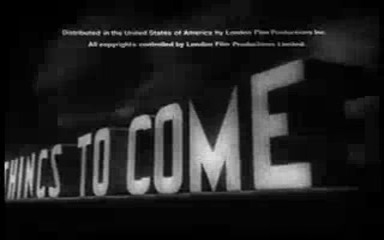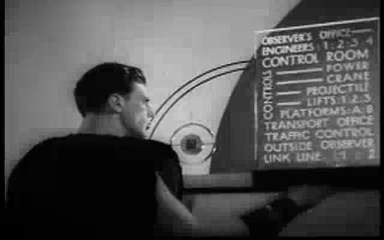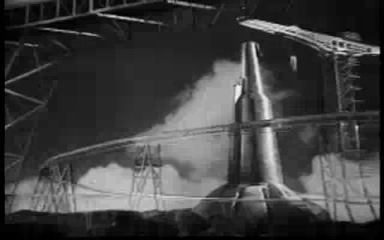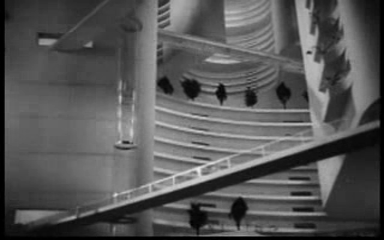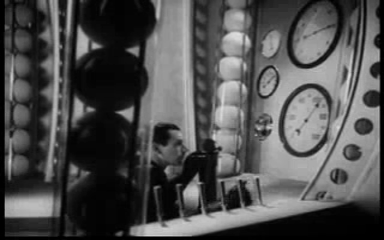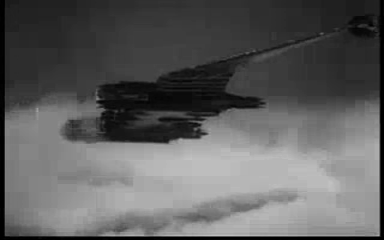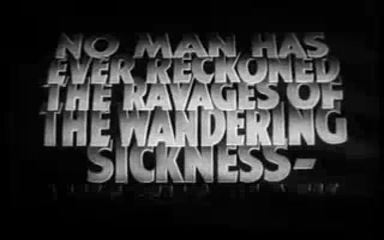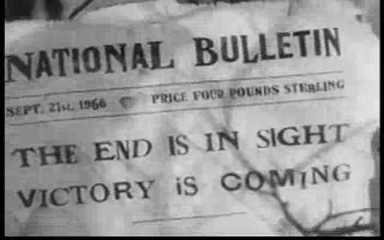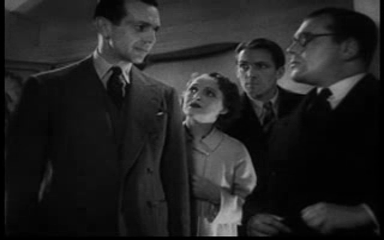-
#15 – Things to Come (1936)
Things To Come (1936)
Film review #15
Director: William Cameron Menzies
A look at just what the future could hold in the next 100 years…
Christmas 1940: In Everytown, John Cabal finds it hard to celebrate because he fears impending war. His feelings are shared by his friend Dr. Harding, but their optimistic friend Passworthy insists that war will advance technological progress if it does happen. Their fears are confirmed later that night when a bombing raid on the town triggers global war. Cabal becomes a pilot and some time later, shoots down en enemy bi-plane. When landing, he pulls the injured enemy pilot from the wreckage, and reflects on the whole madness of war. A little girl runs up to them, closely followed by a poisonous gas cloud. Cabal puts on his gas mask, and the enemy pilot gives his to the girl. Cabal gives the pilot his pistol as he and the girl run, and the pilot shoots himself. The war rages on for over 25 years, resulting in the almost complete collapse of civilisation, with technology being exhausted from fighting and plunging the world into a new Dark Age. With the last few planes, the enemy spreads a disease which becomes known as the “wandering sickness”, of which there is no technology with which to develop a cure.
May Day 1970: In the ruins of Everytown, a man known as The Chief declares he has ridden the world of wandering sickness by shooting everyone who was infected. He still however, wishes to wage war, trying to defeat the “hill people” so he can gain control of the mines and their oil, which he wants to use to power his planes. When a futuristic plane lands outside town, John Cabal emerges and declares himself a part of the new civilisation “Wings Over The World”, based in Basra, Iraq. He says the new world order made of the surviving engineers and mechanics has eradicated war, and abolished independent nations. The Chief refuses to listen to him, and has him locked up. Gordon, a mechanic who The Chief has been ordered to fix the pre-war planes he has, wants to help Cabal, and with the help of Cabal’s old friend, Dr. Harding, fixes a plane and flies to the Wings Of The World headquarters to warn them of Cabal’s imprisonment. They mobilise a fleet, and uses their “peace gas”, drop it on the town and render the population unconscious, and killing The Chief, signalling the end of the old ways of war.
1936: Everytown, and the world is now a futuristic utopia, in which everyone works together for scientific progress and achievement, however a sculptor by the name of Theotocopulos is not content with society, he says man needs a “rest” from the rush of technological progress, with mankind about to take its first manned flight around the moon. Cabal’s great grandson Oswald Cabal is now head of the governing council. His daughter Catherine and her boyfriend Horrie Passworthy insist on being the ones to fly the spaceship. When Theotocopulos rallies a mob to attack the “space gun”, the symbol of the technological progress, Cabal launches the ship ahead of schedule, as the mob descends on the space gun. The movie ends with Cabal reflecting on the nature of progress and what part humanity plays in the quest for knowledge:
“Rest enough for the individual man. Too much of it and too soon, and we call it death. But for MAN no rest and no ending. He must go on–conquest beyond conquest. This little planet and its winds and ways, and all the laws of mind and matter that restrain him. Then the planets about him, and at last out across immensity to the stars. And when he has conquered all the deeps of space and all the mysteries of time–still he will be beginning.”
…
“If we are no more than animals–we must snatch atour little scraps of happiness and live and suffer and pass, mattering no more–than all the other animals do–or have done.” (He points out at the stars.) “It is that–or this? All the universe–or nothingness…. Which shall it be, Passworthy? Which shall it be?”
This film was written by famed Sci-fi screenwriter H.G.Wells (War of the Worlds), and it does what science-fiction does best: Imagines the future, and considers the philosophical implications of said future.
But just how accurate was H.G.Wells’ prediction? Well first of all, most ominously, he predicted the outbreak of a second world war only sixteen months from when it actually happened. The accuracy of which he predicted the use of aeroplanes and bombing raids is also rather eerie. The nationality of the enemy fighters is never mentioned, but it does not take much imagination to say they are German. Luckily, the Second World War only lasted six years rather than the imagined 26 years in the film, and we managed to avoid plunging the world into another Dark Age. Perhaps because of this, we were able to land on the moon a lot earlier than 2036 (1969).
A lot of questions are raised in the film about the relationship between humanity and science: Is there a balance between science and humanism? Mankind must continue to build its knowledge and broaden its horizons, even if there is no limit to what may be learned. So how are we still able to retain our humanity in the face of the overwhelming face of progress? Is war a part of being human itself? These are all questions that still hold relevance today (and always will). The fact that an artist questions the society of 2036 is a point of interest. Is it the artists role to reinforce humanity and to address the problems of society?
The cinematic design of the movie is very well done for its time. The silhouettes of marching soldiers, air raids, and building montages that segue the different sections of the movie really set the mood of the movie and what is happening as the dates and years scroll by on the screen. The changing architecture of the fictional Everytown in Southern England where the town is set also allows the nature of time passing to be seen, from 1930s city, to post apocalyptic ruin, to future metropolis. The same town undergoes a radical transformation over the 100 years that the film depicts.
So in conclusion, Things To Come is an ominous look at the future as seen in 1936, from imagining WWII, to the recovery from the collapse of society from war, the question always remains of how humanity copes with progress and science, and just what being human means in the age of science.
